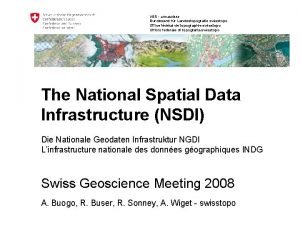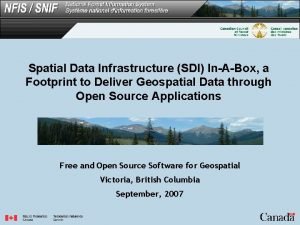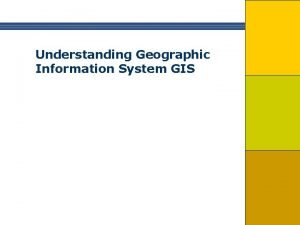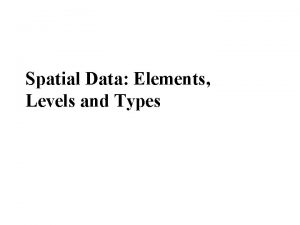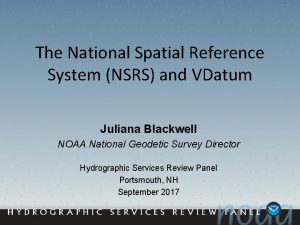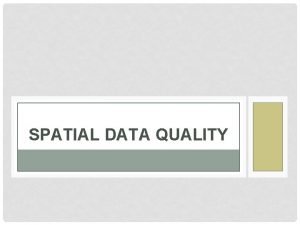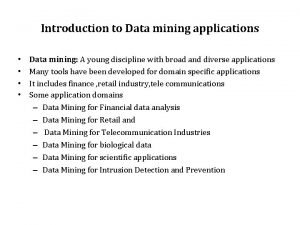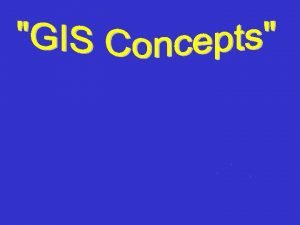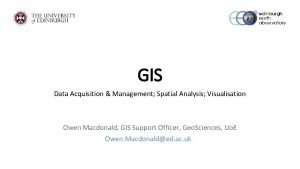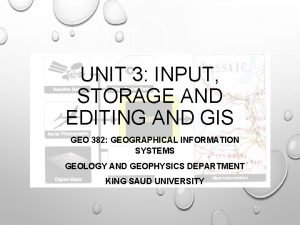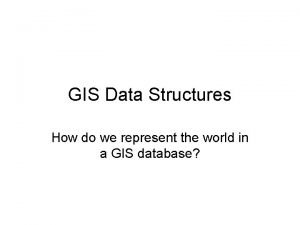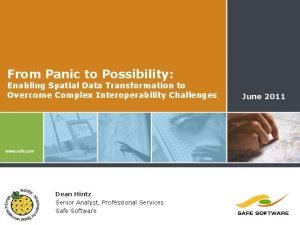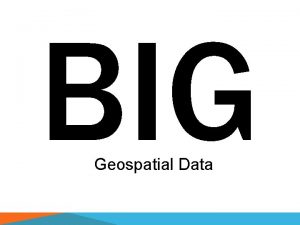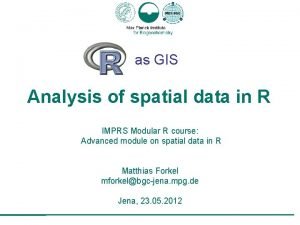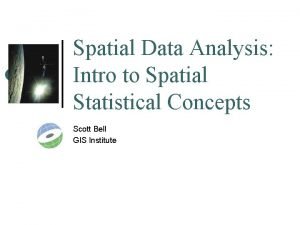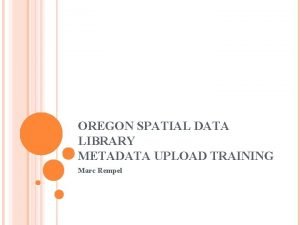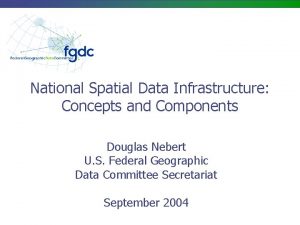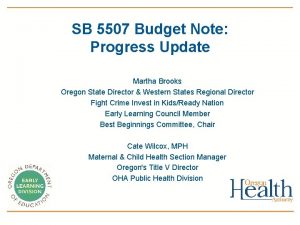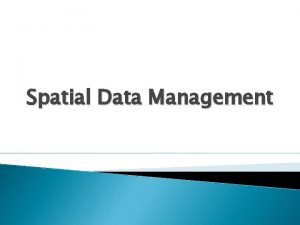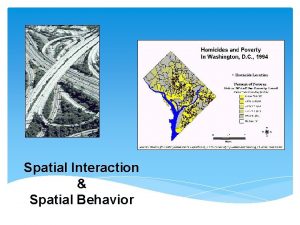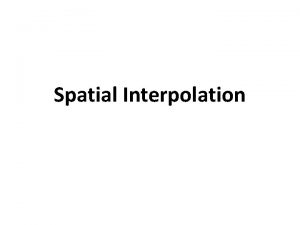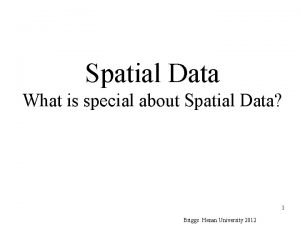SPATIAL INFORMATION MANAGEMENT ECV 5507 NATIONAL SPATIAL DATA




















![References [1]Feeney, M. , Rajabifard, A. & Williamson, I. Future Directions For The Development References [1]Feeney, M. , Rajabifard, A. & Williamson, I. Future Directions For The Development](https://slidetodoc.com/presentation_image_h2/169808c331a1a93e0d68bfdd767f1df9/image-21.jpg)

- Slides: 22

SPATIAL INFORMATION MANAGEMENT ECV 5507 NATIONAL SPATIAL DATA INFRASTRUCTURE Lecturer : Prof. Dr. ABDUL RASHID BIN MOHAMED SHARIFF Master’s Student : OMER SAUD AZEEZ ( GS 46737 )

Contents v Introduction v National Spatial data Infrastructure ( NSDI) v Major areas of NSDI v Elements of Clearinghouse v Geospatial data standards v Framework Data v NSDI Partnership v Malaysia’s National Spatial Data Infrastructure My. GDI v My. GDI as NSDI v Issues and challenges in NSDI implementation v Conclusion v References

Introduction v The spatial data and the geospatial technology are rapidly increased due to their importance and they represent an efficient tool for supporting decision making and the planning activities. v In order to obtain quick decision for any emergency case , government agencies have to ensure that much information needed to make accurate decision related to location of the certain area. v The application of GIS technology can facilitate the analysis of geospatial data , the accuracy of the analysis results depends on the type of data , infrastructure ( hardware , software ) and the human resources. v In the real world , many spatial data collection are redundant because of the lack of cooperation between government and agencies. Therefore, there must have a mechanism to manage the existing data and facilitate the transfer of the spatial data between stakeholders and users. v Many countries developed a special infrastructure called National Spatial Data Infrastructure NSDI to manage there spatial data.

National Spatial data Infrastructure ( NSDI) v Spatial Data Infrastructure (SDI) is about the facilitation and coordination of the exchange and sharing of spatial data between stakeholders in the spatial data community. With this objective in mind, many countries are developing SDI to manage and use their spatial data assets more efficiently. These countries are finding it necessary to develop SDIs to assist in decisionmaking that has an important impact within their national boundaries. v National Spatial Data Infrastructure ( NSDI) is a mechanism which acts as an umbrella of the policies regarding of the spatial data, the procedures of the data acquisition and also the data collection. It also sets the standards of collected data within certain level of quality of metadata and NSDI also will introduce the technologies which will contribute the quality of the data. v The main goals of the NSDI are to reduce redundancy in geospatial data creation and maintenance, reduce the costs of geospatial data creation and maintenance, improve access to geospatial data, and improve the accuracy of geospatial data used by the broader community.

Major areas of NSDI q National Geospatial data Clearinghouse v Clearinghouse is an effort of which to use the existing and expanding information infrastructure Of geospatial data which existed in the database. By implementing the clearinghouse, it can help to facilitate access to geospatial itself. There are three elements of Clearinghouse : 1 - Federal Geographic Data Committee ( FGDC) geospatial metadata standard 2 - Data documented electronically accessible on the internet 3 - Use of software tools for search and query data on network

Elements of Clearinghouse 1 - Federal Geographic Data Committee ( FGDC) geospatial metadata standard. In FGDC geospatial metadata standard, all data producers including government agencies and also private sectors is demanded to document or describe the data that they produce within geospatial metadata standard which has been determined by the NSDI committee. This is to describe the details of how the data being captured , the parameters that adopted to collect the data. And also the determine the quality of the collected data. 2 - Data documented electronically accessible on the internet. In NSDI initiative , the data producers including government agencies and private sectors are encouraged by the committee to establish internet connection for their own organizations. These efforts are to encourage them to make their data available and accessible through the internet, providing data publicity of owned data by certain organizations to the industry player and also encourage the data sharing either by fair use, purchasing or licensing.

Example of Metadata There are many metadata standards. For example the ESRI metadata is one of the most popular metadata standards, information that describes items in Arc. GIS is called metadata. When care is taken to provide good descriptions, you can find appropriate items with a search and evaluate which of the items in your search results is the correct one to use.

Elements of Clearinghouse 3 - Use of software tools for search and query data on network NSDI encourage data providers to make use of the software tools for search and query of the data on the network, either through the internet or intranet. These technologies will provide the ability for the data provider as well as users to document the data which they own , to get the access and retrieve the geospatial data in which may vary in scope, context, format , detail and also location of the data. The data producers were allowed advertising their available data to users. On the other hand, the users can access , retrieve and also make use of data depends on the policies of the data that sets by the committee and the data providers. The data policies should be allow easy access , equitable of the data information , minimal constraint of access of data and also the use of data itself.

Geospatial data standards In geospatial data standards , there are multiple standards that developed within FGDC committee : 1 - Standard Working group In this group , the committee is working on determining the metadata standard of each geospatial data. This to ensure the standard of the data based on the guidelines that determined by the committee itself. 2 - Spatial data transfer standards This standard will assure the policy to allow transfer of digital data without any loss of content either by coincidence or determine to do so by data providers.

Geospatial data standards 3 - Various Committee In the Various Committee, they are working on data content standard which standardizing the way of classify , collect and represent specific themes of data for data integration. The main goal of the geospatial data standards is to facilitate the process of sharing data by making standard of each data provider must obey in order to make data sharing easy and without any fuss. And it also ensure that data which have being collected must match the minimal criteria that determined by the committee. The standard that being determined by the committee will become the statement of policy specific to data collection and management activities regarding of geospatial data collection and sharing.

Framework Data The framework of the data in NSDI is a part of crucial element s in assuring the success of the infrastructure planning. In order to work with the framework data, FGDC establish frameworking group. This group will address the issues which associated with developing commonly required data sets of geospatial data. In this framework, FGDC will determine the minimal information that must have for the data as the example is geodetic control , orthoimaging , transportation , hydrology , elevation, government units and Cadastral data. Besides, the information will be extended based on the type of application and the characteristic of data itself. For the data collection procedure , users usually are independent to digitize or to capture data of various resolution of the data source. Therfore from the lack of dependable of data collection and analysis , the constancy and the knowledge of existing data can be questionable. This is because usually the work was done without standards and one shot approaches of data collection and analysis.

Framework Data The framework of the data in NSDI is a part of crucial element s in assuring the success of the infrastructure planning. In order to work with the framework data, FGDC establish frameworking group. This group will address the issues which associated with developing commonly required data sets of geospatial data. In this framework, FGDC will determine the minimal information that must have for the data as the example is geodetic control , orthoimaging , transportation , hydrology , elevation, government units and Cadastral data. Besides, the information will be extended based on the type of application and the characteristic of data itself. For the data collection procedure , users usually are independent to digitize or to capture data of various resolution of the data source. Therfore from the lack of dependable of data collection and analysis , the constancy and the knowledge of existing data can be questionable. This is because usually the work was done without standards and one shot approaches of data collection and analysis.

Framework Data Therefore, to overcome this issue and generate more credible data , the concept of national digital framework data sets is established. The framework will be based on the number of data production The exactly same data not required by the framework, but the data must meet the minimal level of standards which has being determined before to assure the quality of data. It is because the data itself is being derived from multitude source of data which depends on the ability of free access and integrate existing data. The main goal of this framework establishment is to provide a base which can being used by data collectors to facilitate data integration in immediate future.

NSDI Partnership The NSDI is build on the existing and to be formed institution which the main role is to facilitate geospatial data community to share information to each other. Therefore , a creative partnership is needed from all levels ( government , private agencies and academia ) in order to realize the dream of NSDI establishment. Experts from various fields and levels must get together to create a policies which will encourage the development the infrastructure which can help to minimize constraints of contracts and memorandum of understanding (Mo. U) of data sharing policy , yet also will help to facilitate the government agency and private sectors data integration which is the main objective of the NSDI development.

Malaysia’s National Spatial Data Infrastructure My. GDI is a Malaysian government initiative to develop a geospatial data infrastructure. By development of this infrastructure , its hope that it will increase the awareness of about the existing data collection. The development of this infrastructure also could lead into an easy data access and also information sharing between agencies within Malaysia. In brief, My. GDI will act as a NSDI which consists of the technologies that will be used for the geospatial, the policies of data integration , setting up and maintain the standards of the data and prepare the procedures of the information sharing and cooperation between the government agencies within Malaysia.

My. GDI as NSDI The Infrastructure of My. GDI almost the same as NSDI which is being implemented in the United States. This is because My. GDI setup based on NSDI in USA as first country introducing this infrastructure. Hence, there is a slight differences between My. GDI and NSDI in the USA as My. GDI adopts the NSDI with several adjustments to fit with the Malaysian government policy. AS in the NSDI the government agencies working together with the private sector , while My. GDI the private sector involvement is not widely involved for My. GDI as private sector have some restriction of data using provided by the government agencies. My. GDI establishment is more focus for the use of inter government agencies comprising the federal and state government. This is to ensure the collaboration between federal and state government in the data integration and sharing and yet to create smooth data flow over the agencies. The results of the My. GDI is the establishment of My. Geoportal as geo-information one stop service which is for the government agencies and also private agencies or users with several restrictions.

My. GDI as NSDI In order to increase the effectiveness of My. GDI as state of art government data integration, cooperation among the government agencies is needed to ensure the objective of the infrastructure being achieved. And also to ensure the success implementation , public sector cooperation is needed for responsible of setting the standards of the data collection and uniform data standards which will ease the integration of data and c compatibility of data for various platforms which is crucial for data sharing ideology. To achieve all of this, the public and private sectors should work closely and cooperatively to design and develop the infrastructure. The government should widening the coverage of My. GDI service for users from public and private sector without much constraint in order to market the technology and services related to My. GDI.

NSDI development in middle east countries v The middle east countries like Iraq are recently , planning to develop their NSDI although there is a lack in the adequate infrastructure. v In mid-February 2012, over 25 persons representing 13 national and regional government organizations assembled in Erbil in the north of Iraq for an intensive three-day exchange to explore concepts and ideas towards the establishment of a National Spatial Data Infrastructure for Iraq. v The workshop was conducted under the auspices of the Prime Minister Advisory Committee (PMAC), and supported by the United States Geologic Survey (USGS) v Staff from the GPC Group facilitated the workshop, bringing experience and insights regarding the implementation of GIS federations and Spatial Data Infrastructure (SDI) in other countries and regions around the world v This workshop paved the way for estblishing the NSDI for Iraq, this project is still under progressing.

Issues and challenges in NSDI implementation v Availability of quality digital data. v Legal arrangements v Institutional arrangements v Partnership arrangements v Lack of awareness in GIS and SDI v Capacity building v Clear SDI directives v Lack of funding on GIS-based Projects v Adoptions of standards v Access Delivery Mechanism v Lack of Knowledge and skills v Data Interoperability v Cultural (reluctant to change) v Language barriers v Socio and political stability v Metadata availability

Conclusion v The development and implementation of NSDI in various countries is one steps of the development for Global SDI. v The goals of the NSDI are to reduce redundancy in geospatial data creation and maintenance, reduce the costs of geospatial data creation and maintenance, improve access to geospatial data, and improve the accuracy of geospatial data used by the broader community. v The Policies of NSDI which being implemented also must be transparent enough to benefit the users and contribute the development of the infrastructure itself v The infrastructure which being developed also must be reliable yet secured for users and data provider as well as technology used. v The strategic partnership is needed as the all parties which involved must have beneficial contribution and boost development of the NSDI itself. v We urge that the governments in the developing countries to establish their NSDI due to it's importance in the development planning.
![References 1Feeney M Rajabifard A Williamson I Future Directions For The Development References [1]Feeney, M. , Rajabifard, A. & Williamson, I. Future Directions For The Development](https://slidetodoc.com/presentation_image_h2/169808c331a1a93e0d68bfdd767f1df9/image-21.jpg)
References [1]Feeney, M. , Rajabifard, A. & Williamson, I. Future Directions For The Development Of Spatial Data Infrastructure. International Journal of Applied Earth Observation and Geoinformation. Vol. 1, 2002, pp. 1– 12. [2]Foresman, T. W. Progress With The Digital Earth Global Infrastructure. Paper Presented At 7 th GSDI Conference, 2 -6 Feb 2004 India. Retrieved April 23, 2007, from http: //www. gsdidocs. org/docs 2004/stratim. html [3]Masser, I. The First Generation of National Geographic Information Strategies. Paper presented at the Third Global Spatial Data Infrastructure Conference, November 1998, Canberra. Retrieved Mac 6, 2007, from http: //gsdidocs. org/docs 1998/canberra/masser. html [4]Masser, I. Report on A comparative Analysis of NSDI. GINIE: Geographic Information Network in Europe, 2002.

Terima Kasih | Thank You
 Ecv expected commercial value
Ecv expected commercial value Spatial data vs non spatial data
Spatial data vs non spatial data National spatial data infrastructure
National spatial data infrastructure National spatial data infrastructure
National spatial data infrastructure Components of gis
Components of gis Spatial data and attribute data
Spatial data and attribute data National spatial reference system
National spatial reference system Spatial data quality
Spatial data quality Spatial data mining applications
Spatial data mining applications Spatial data acquisition
Spatial data acquisition Gis hardware components
Gis hardware components Gis
Gis Big spatial data
Big spatial data Spatial data editing in gis
Spatial data editing in gis Spatial big data platform
Spatial big data platform Spatial data structures in gis
Spatial data structures in gis Spatial data transformation
Spatial data transformation Spatial big data
Spatial big data Applied spatial data analysis with r
Applied spatial data analysis with r What is spatial data?
What is spatial data? Oregon spatial data library
Oregon spatial data library Spatial data infrastructure components
Spatial data infrastructure components National unification and the national state
National unification and the national state


